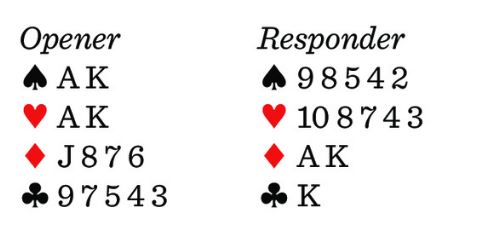Fuente: June 2016 ACBL Bridge Bulletin ![]()
![]()
![]()
![]()
At this juncture, I hope you question any absolute allegiance to the point-count gods on distributional hands. For instance, let’s say you are dealt:
In third seat you open 1![]() , LHO intervenes with1
, LHO intervenes with1![]() , partner responds 1
, partner responds 1![]() , and RHO raises to 2
, and RHO raises to 2![]() . With nothing to say, you pass to limit your hand. LHO passes and partner, a passed hand, jumps to 4
. With nothing to say, you pass to limit your hand. LHO passes and partner, a passed hand, jumps to 4![]() , back to you. What’s your evaluation?
, back to you. What’s your evaluation?
5![]() , a game usually requiring extra high-card points, may seem a distant proposition, but try to picture partner’s hand and ask yourself, “How will it play?” Partner’s 1
, a game usually requiring extra high-card points, may seem a distant proposition, but try to picture partner’s hand and ask yourself, “How will it play?” Partner’s 1![]() call showed five (no negative double), and his club jump should deliver at least five-card support because he bypassed 3NT, showing extreme distribution. What about his red suit lengths?
call showed five (no negative double), and his club jump should deliver at least five-card support because he bypassed 3NT, showing extreme distribution. What about his red suit lengths?
The opponents didn’t compete beyond 2![]() , suggesting that partner holds some heart length, either two or three. That leaves partner with a singleton or void in diamonds. Piecing the clues together, visualize partner with the representative hand below and decide what contract you want to play.
, suggesting that partner holds some heart length, either two or three. That leaves partner with a singleton or void in diamonds. Piecing the clues together, visualize partner with the representative hand below and decide what contract you want to play.
6![]() is excellent on a combined 21 HCP. The only real danger is a 3-0 club split, and, if that were the case, the opponent with a club void and a heart fit would certainly have competed beyond 2
is excellent on a combined 21 HCP. The only real danger is a 3-0 club split, and, if that were the case, the opponent with a club void and a heart fit would certainly have competed beyond 2![]() . If you don’t want to jump to slam, cuebid 4
. If you don’t want to jump to slam, cuebid 4![]() to show the control, plus slam interest. Partner, rich in controls, will cooperate, and slam should be reached.
to show the control, plus slam interest. Partner, rich in controls, will cooperate, and slam should be reached.
The reason your minimum opening became so powerful is that all your honor cards meshed perfectly with partner’s values. Your spade royals became magisterial, and there was no diamond wastage facing partner’s shortness. Another useful principle of hand evaluation is to demote hands where your honors are concentrated in short unbid suits, quite unlike the previous deal where your short spade honors were located opposite partner’s first-bid suit.
For instance, you pick up:
This may look like a normal 1NT opening (15-17), but the point count is deceptive. The hand counts to 15 HCP but it is worth less – the long suits are ragged because the aces and kings are packed into the doubletons. Weak long suits take time to establish, an ominous sign for notrump contracts which, typically, are a race. In a bidding contest, the responding hand was:

Both pairs reached all-but-hopeless game contracts after a 1NT opening bid. In 4![]() , declarer rates to begin with two trump losers. If he ruffs hearts to establish his side suit, his trump losers mount because he must ruff with the
, declarer rates to begin with two trump losers. If he ruffs hearts to establish his side suit, his trump losers mount because he must ruff with the ![]() A K.
A K.
In notrump, by the time declarer sets up a long major, the defense should be able to run clubs. If opener had chosen 1![]() and rebid 1NT, treating his hand as worth 12-14, the partnership would have stopped below game, e.g.,1
and rebid 1NT, treating his hand as worth 12-14, the partnership would have stopped below game, e.g.,1![]() -1
-1![]() ;1NT-2
;1NT-2![]() ; 2
; 2![]() -Pass. Both hands contain emaciated long suits, a clear indication to demote the hands’ point count.
-Pass. Both hands contain emaciated long suits, a clear indication to demote the hands’ point count.
When re-evaluating, don’t worry about finding a formula to provide an exact point count measurement. If there were such a formula, only an Einstein could use it. Instead, think in terms of upgrades or downgrades and adjust your bidding accordingly. Remember, the proof lies in how well, or poorly, the partnership hands generate tricks.
Esta entrada también está disponible en: Spanish


